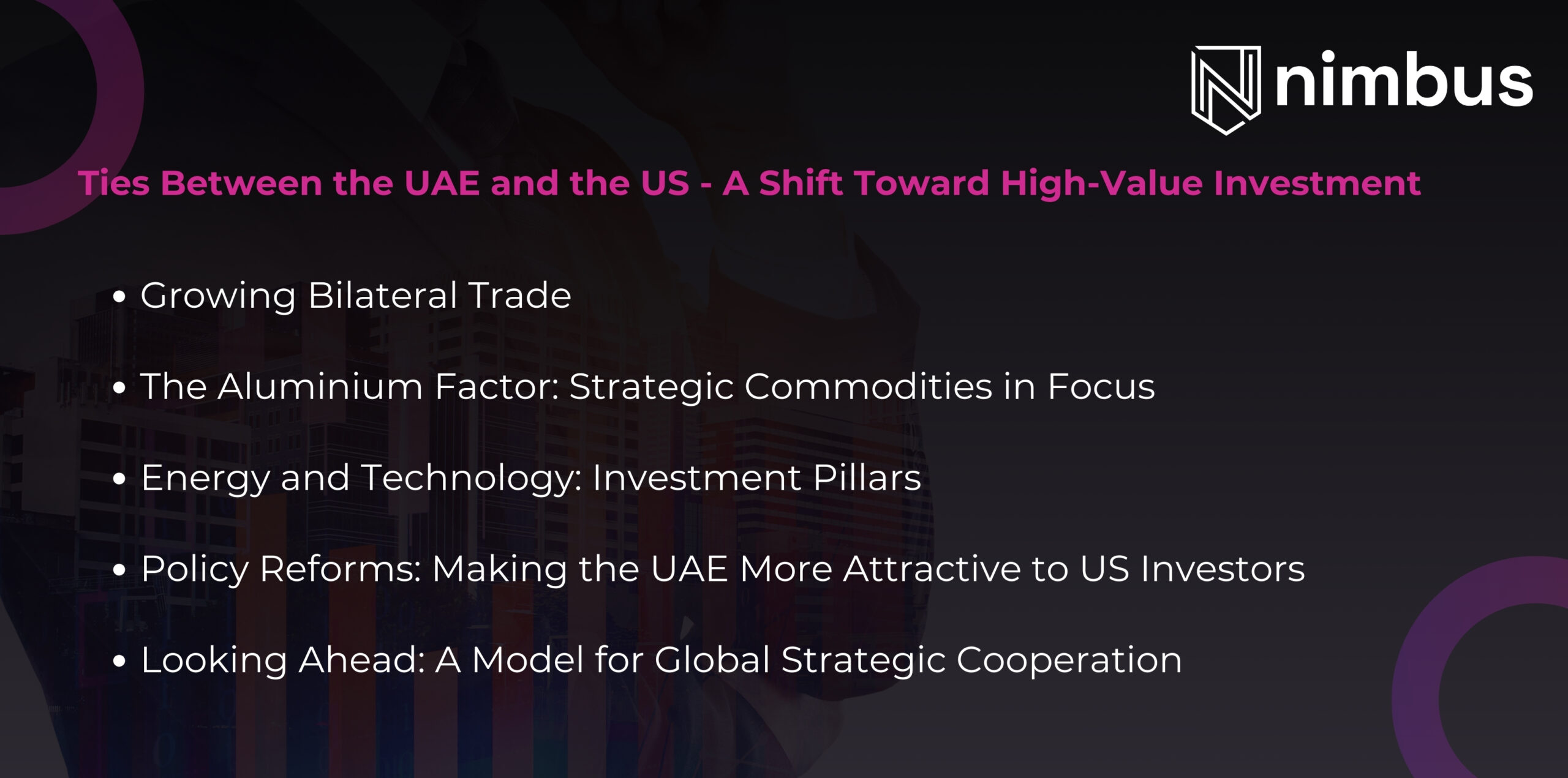In recent years, the economic relationship between the UAE and the US has evolved from a traditional trade partnership into a multifaceted collaboration rooted in high-value investment, innovation, and strategic cooperation.
From energy infrastructure to AI, and from clean energy projects to advanced manufacturing, the UAE is emerging as one of the US’s most significant economic allies in the Middle East.
This blog post explores how the UAE is expanding its economic footprint in the US, the sectors driving this growth, and the regulatory and diplomatic frameworks that are facilitating deeper ties between the two nations along with business setup in the UAE.
Ties Between the UAE and the US – A Shift Toward High-Value Investment

The UAE’s economic diversification strategy has led to strategic partnerships with other nations, especially with the US. This beneficial partnership is reflected in a series of investments and agreements.
One of the most prominent is the US$25 billion joint venture between Abu Dhabi Developmental Holding Co. (ADQ) and US-based Energy Capital Partners (ECP). This venture is designed to expand energy infrastructure to support data centers and AI applications.
Additionally, the announcement of a US$1.4 trillion investment framework in March 2025 underscores the UAE’s growing commitment to supporting large-scale economic initiatives in the US. This substantial investment reflects both countries’ goals of fostering sustainable growth through innovation and diversification.
– Growing Bilateral Trade
The UAE has been the largest export market for US goods in the Middle East for many years, and 2024 was no exception. Bilateral trade reached US$34.4 billion, with the US maintaining a trade surplus of US$19.5 billion. This indicates not only strong demand for American products in the UAE but also a high degree of economic integration. In 2023, the UAE’s top exports to the US included:
- Precious metals and stones – US$3.04 billion
- Printed materials – US$2.33 billion
- Aluminium products – US$1.78 billion
- Electrical machinery – US$1.44 billion
At the same time, the UAE’s imports from the US focused on high-value industrial and technological products:
- Machinery and mechanical appliances – US$7.52 billion
- Vehicles – US$4.97 billion
- Aerospace components – US$1.85 billion
- Electrical equipment – US$1.77 billion
These figures reflect a mutual reliance on specialized goods and advanced technologies that form the backbone of both economies.
– The Aluminium Factor: Strategic Commodities in Focus
Aluminium is a key commodity that illustrates the strategic nature of UAE-US trade. The UAE was the second-largest supplier of aluminium to the US in 2024, providing 8 percent of total US consumption.
In early 2025, US aluminium imports from the UAE surged in anticipation of new 25 percent tariffs. In just the first eleven days of March, the UAE exported 68,560 metric tonnes of aluminium to the US, more than four times the monthly volume in March 2024.
Despite the tariffs, Emirates Global Aluminium (EGA), the UAE’s flagship producer, remains competitively positioned due to its low production costs. This gives it a significant edge, particularly as US buyers seek alternatives to Canadian suppliers, who currently account for 70 percent of US aluminium imports.
– Energy and Technology: Investment Pillars
Energy cooperation continues to be a foundational element of UAE-US relations. However, the focus has expanded far beyond oil and gas. Key initiatives include:
- ADNOC’s investment in US natural gas, including its stake in the NextDecade LNG project in Texas
- Masdar’s US$15 billion clean energy initiative, part of the UAE’s goal to derive 50 percent of its energy from renewables by 2050
- The Partnership for Accelerating Clean Energy (PACE), a joint UAE-US platform supporting carbon reduction and clean energy solutions
Furthermore, sovereign wealth funds like Mubadala, ADIA, and ADQ have made substantial investments in US-based tech companies, with interests spanning semiconductors, life sciences, and AI-driven platforms.
– Policy Reforms: Making the UAE More Attractive to US Investors
To encourage further bilateral investment, the UAE has implemented a series of policy reforms including:
- The introduction of a federal Corporate Tax Law
- Revisions to the Commercial Companies Law, allowing 100 percent foreign ownership in many sectors
- Investment platforms like Invest in Dubai and land discount programs in Abu Dhabi that simplify company formation in the UAE for foreign businesses
– Looking Ahead: A Model for Global Strategic Cooperation
The UAE’s economic engagement with the US is moving beyond transactional trade into a strategic partnership. By aligning investments with global trends like clean energy, AI, and advanced manufacturing, the UAE is becoming a major player in shaping the future of global markets.
At the same time, the US benefits from a reliable partner in the Gulf, one that brings not only capital but also a forward-looking vision and a willingness to invest in areas critical to future prosperity.
As both nations continue to prioritize innovation, sustainability, and shared economic growth, the UAE-US relationship is poised to serve as a model for how strategic cooperation can redefine traditional trade dynamics and generate global impact.
In a world of shifting alliances and economic uncertainty, this partnership stands out not only for its scale but for its direction towards a future where collaboration and innovation drive success across borders.



